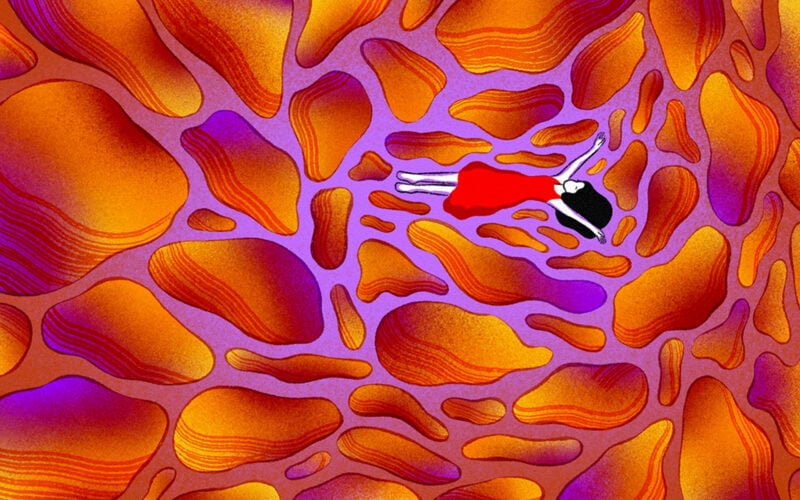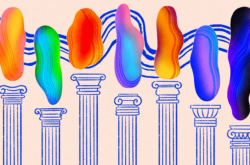Illustration: Nhung Lê
The Mixolydian mode is one of the seven common diatonic modes.
While it’s best known for its bold sound, the Mixolydian mode can be used in an incredibly wide range of musical contexts. In this article, let’s discuss what exactly the Mixolydian mode is, some popular pieces of music that make use of it, and how to apply it to your own compositions.
Feel free to use the table of contents below to quickly navigate to a specific section.
What you’ll learn:
- What is the Mixolydian mode?
- The Mixolydian scale formula
- The Mixolydian scale in all “keys”
- Songs that use the Mixolydian mode
- When to use the Mixolydian mode in your music
Let’s get started!
What is the Mixolydian mode?
The Mixolydian mode is a mode that’s in many ways similar to major, but features a flattened seventh (♭ˆ7) as its distinguishing feature. If we started on G, then its ascending scale would consist of G, A, B, C, D, E, and F.

The G Mixolydian scale
The history of the Mixolydian mode
The Mixolydian mode gets its name from the terms “mixo” (a prefix for “mixed” in Greek) and “lydian” (referring to the Lydian mode). The ancient Greek Mixolydian mode’s invention is speculated to have occurred around 700 B.C., and is frequently credited to poet and musician Sappho. However, this version of the mode is quite different from the modern iteration we know today—most often used in secular music across the ages, it evolved slowly over the course of the Middle Ages, Renaissance, and Baroque Era.
Today, the Mixolydian mode is used to create melodic and harmonic interest in various genres, including the likes of rock, pop, jazz, and folk music. It’s also commonly featured in film and video game soundtracks to achieve an array of moods spanning heroic and confident to playful and medieval.
The Mixolydian scale formula
As you can decipher from the previous example, the Mixolydian scale consists of the following intervals:
- Root
- Major second
- Major third
- Perfect fourth
- Perfect fifth
- Major sixth
- Minor seventh
If you were to sequence an ascending scale, the intervals could be expressed in shorthand as WWHWWHW (‘whole whole half, whole whole half whole’).
Once you familiarize yourself with this pattern, you can apply it to build a Mixolydian scale off of any other root note. For example, here are the notes for a C Mixolydian scale using this formula:
- C
- D
- E
- F
- G
- A
- B♭
- C
Transposing the root to A, here are the notes for an A Mixolydian scale:
- A
- B
- C♯
- D
- E
- F♯
- G
- A
What’s the difference between the Mixolydian and Dorian scales?
At first, you might be confused about the differences between popular modes. For example, the Dorian mode, while also widely used, is a ‘minor mode’ that’s in many ways similar to natural minor, but features a raised sixth (♯ˆ6) as its distinguishing feature. By contrast, the Mixolydian mode is a ‘major mode’ that features a flattened seventh.
The Mixolydian mode in all “keys”
While familiarizing yourself with the sequence of intervals is far more valuable (and easier) than memorizing each and every scale one-by-one, here’s a table that outlines the Mixolydian scale associated with every root note for easy reference:
| Root | Notes in the Mixolydian scale |
| C | C – D – E – F – G – A – B♭ – C |
| C♯ | C♯ – D♯ – E♯ – F♯ – G♯ – A♯ – B – C♯ |
| D♭ | D♭ – E♭ – F – G♭ – A♭ – B♭ – C♭ – D♭ |
| D | D – E – F♯ – G – A – B – C – D |
| D♯ | D♯ – E♯ – F♯♯ – G♯ – A♯ – B♯ – C♯ – D♯ |
| E♭ | E♭ – F – G – A♭ – B♭ – C – D♭ – E♭ |
| E | E – F♯ – G♯ – A – B – C♯ – D – E |
| F | F – G – A – B♭ – C – D – E♭ – F |
| F♯ | F♯ – G♯ – A♯ – B – C♯ – D♯ – E – F♯ |
| G♭ | G♭ – A♭ – B♭ – C♭ – D♭ – E♭ – F♭ – G♭ |
| G | G – A – B – C – D – E – F – G |
| G♯ | G♯ – A♯ – B♯ – C♯ – D♯ – E♯ – F♯ – G♯ |
| A♭ | A♭ – B♭ – C – D♭ – E♭ – F – G♭ – A♭ |
| A | A – B – C♯ – D – E – F♯ – G – A |
| A♯ | A♯ – B♯ – C♯♯ – D♯ – E♯ – F♯♯ – G♯ – A♯ |
| B♭ | B♭ – C – D – E♭ – F – G – A♭ – B♭ |
| B | B – C♯ – D♯ – E – F♯ – G♯ – A – B |
Is Mixolydian major or minor?
As we mentioned in our article on the Phrygian mode, we use the term “key” loosely to refer to these because modes don’t follow the same functional behaviors of traditional major and minor keys, which are a requisite of the term in its strictest definition. While we may group modes into ‘major’ and ‘minor’ depending on the quality of the third, it’s worth noting that Mixolydian (and every other common diatonic mode) is neither major or minor in respect to the concept of keys.
Songs that use the Mixolydian mode
While scales are a necessary starting point, they don’t paint a complete picture of the Mixolydian mode’s sound by themselves. Let’s begin to familiarize ourselves with the mode by listening to a few pieces of music from varying genres and contexts that feature its sound.
1. “Title Screen” by Junichi Masuda (from Pokémon) (1996)
It wouldn’t be an understatement to say that the Pokémon soundtrack is defined by the ♭VII chord, which is the signature chord of the Mixolydian mode. For just one of many examples, take a listen above to the main melody of the iconic opening theme from the original games. The primary chord progression consists of a simple oscillation between the I and ♭VII chords, and the melody unapologetically emphasizes the flattened seventh by landing and sustaining on it almost immediately.
Here, the Mixolydian mode is used to evoke the feeling of adventure—the flattened seventh introduces a hint of peril, but the overall major sound keeps things feeling grand and optimistic.
2. “Royals” by Lorde (2013)
The Mixolydian mode makes a surprising number of appearances in pop music as well—look no further than “Royals,” the track that raised Lorde to prominence in 2013. While its sound is immediately present, you can hear the Mixolydian mode’s flattened seventh particularly clearly in both the melody and chord progression as she delivers the line, “We don’t care” in the pre-chorus.
While the arrangement of “Royals” is minimal and modest, the Mixolydian mode achieves a sense of unwavering confidence, which effectively synergizes with the lyrics to deliver the song’s distinctive charm.
3. “Bitter Sweet Symphony” by The Verve (1997)
Last but not least, let’s take a look at The Verve’s ageless “Bitter Sweet Symphony.” The song revolves around a sample from a 1965 version of the Rolling Stones track “The Last Time” performed by the Andrew Oldham Orchestra. Within this sample, the Mixolydian sound is once again evident in both the melody and the harmony, and helps create a grand—while bittersweet—sound.
How to use the Mixolydian mode
As you can gather from listening to the examples above, there’s no finite set of rules for when and how to use the Mixolydian mode in your own music. That said, if you want to experiment with it but aren’t sure where to start, we’ve highlighted a few ideas below that you can try out to develop your own unique applications and associations.
1. Add a bold touch to your music
Whether it’s a heroic sound akin to the Pokémon theme or the understated confidence of “Royals,” the Mixolydian mode is a great tool for making a statement with your music. If you’re looking to introduce a bold sound in an unexpected but structured way, consider incorporating the mode’s flattened seventh in your melody or harmony (or both) and playing with the resulting sound.
2. Achieve a passing moment of intrigue
While our examples used the Mixolydian mode fairly extensively throughout their compositions, note that it doesn’t need to be used as the sole harmonic backbone of your music. Whether you’re composing an orchestral score or soloing on your instrument, consider introducing a moment of Mixolydian color before pivoting back to major, minor, or perhaps even another mode of your choosing. Although it only differs from major by a single note, that can be plenty to introduce some variety and re-engage a listener’s attention.
3. Introduce some humor
While many of us strive to make tracks that are cool, beautiful, or emotional, one thing that music can also be is funny. In the video below, 8-bit Music Theory analyzes multiple pieces of video game music to explore how the Mixolydian mode can also be used to introduce a sense of humor to music.
Conclusion
While there’s no one way to use it, the Mixolydian mode provides a distinctive color that’s a great addition to any composer’s toolkit. Hopefully this article gave you a foundation for how it’s structured, and provided you with some initial ideas for using it that you can apply to create your own unique musical settings.
Do you have any questions around using modes in your music? What other topics in music theory would you like to see us cover next? Start a conversation with us and other music creators via the Splice Discord.
Continue your exploration of modes in music:
May 22, 2023



